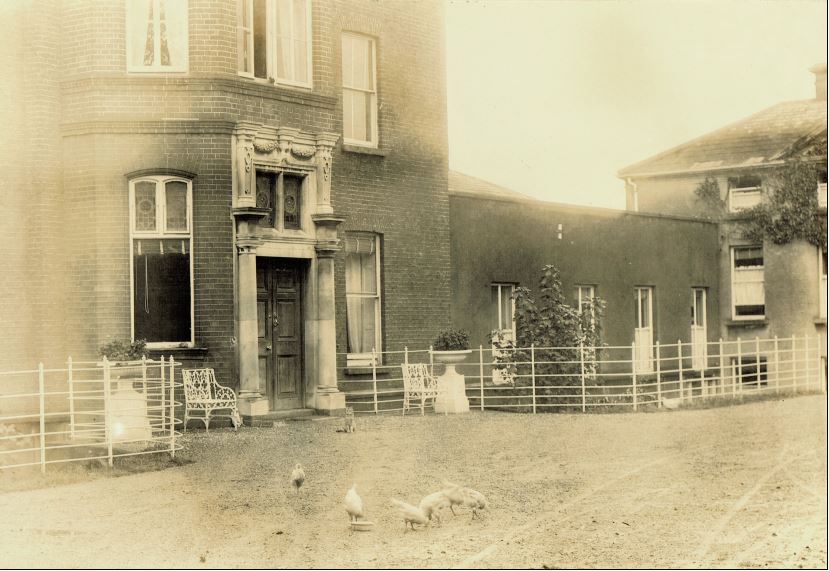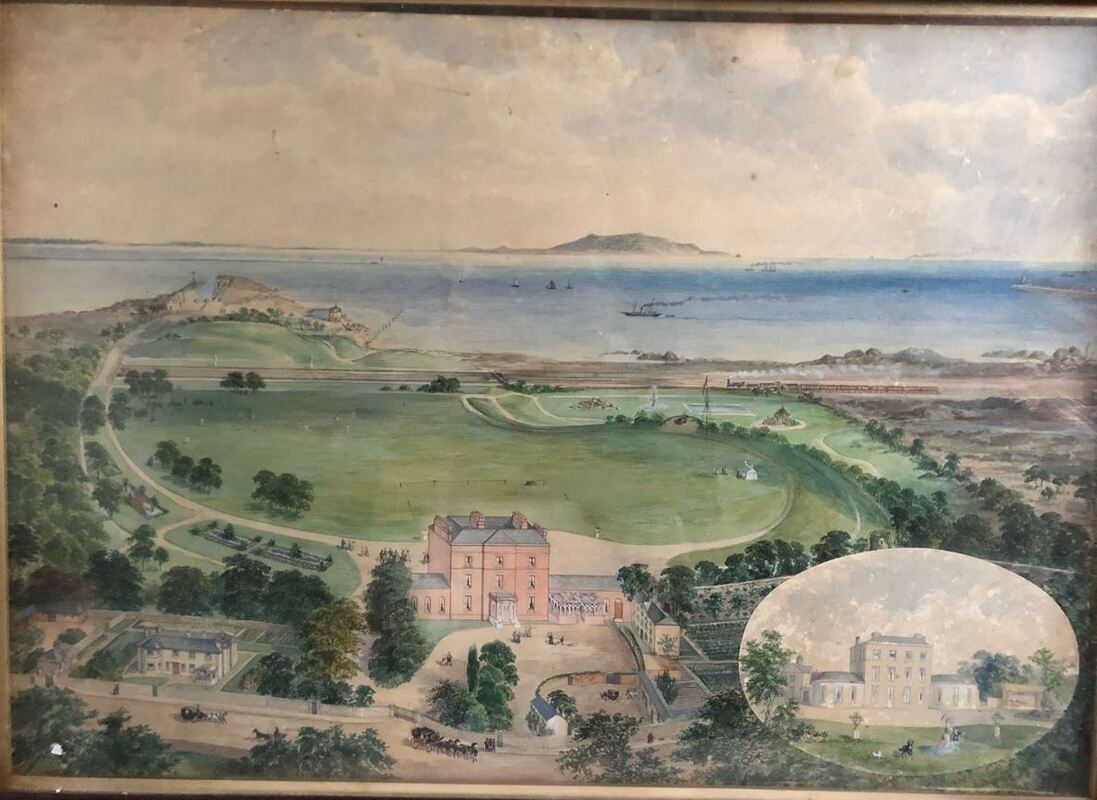Blackrock House
Name Blackrock House is the current and the original name of the residence. In the late 1700s and up to its entry in the Tithes Applotment Books of 1826 the house was called Rutland Lodge, acknowledging its role as the summer residence of several Lords Lieutenants of Ireland and in particular of Lord Rutland.
Area Location Today the address of Blackrock House is Newtown Avenue, Blackrock in County Dublin, Newtown Avenue having been the main road from Blackrock Village to Seapoint Avenue before construction of the Blackrock bypass. But the original townland address of the house and site was Newtown on the Strand, or alternatively Newtown Castlebyrne. These names are found in various deeds related to the house. In 1792 Finn's Leinster Journal reported a duel in Newtown Avenue “near Black-rock”. In 1853 Griffith's Valuation places the house in the North East of the townland of Newtown Blackrock. By the 1901 census the same townland was designated simply Blackrock. Blackrock House fronts on to Newtown Avenue, close to the other grand residences of Blackrock Lodge, Newtown House and Seapoint Manor (formerly Castlebyrn). Maretimo, the seaside residence of the Lords Cloncurry, was also nearby but was demolished in the 1970s.
Map location Taylor's map of 1810 and Duncan's map of 1821 name Rutland Lodge. The 1837 OSI map shows the house but does not name it although it names the neighbouring houses of Maretimo, Newtown House and Castle Byrne. It is named on Griffith's map as Black Rock House.
General Blackrock House was built c1774 and is thus in the Georgian style. Griffith's describes it as “a fine House two stories high and slated, having good office houses, garden and orchard”. The house now is three-storied over basement. Was Griffith mistaken or is the third storey a later addition? The house is unusual in that its red brick exterior when most houses of the period were rendered.
In 1837 Samuel Lewis in his Topographical Dictionary of Ireland remarks that “Maretimo, the marine villa of Lord Cloncurry, and Blackrock House, the residence of the Rev. Sir Harcourt Lees, Bart., are beautifully situated; the Dublin and Kingstown railway passes through the grounds of both these seats”.
At some stage a two-storey porch of red brick and Portland stone, and having five windows, was added. Two further windows are set above the six-paneled door. All the windows in the porch and above the door have stained glass features. Two columns frame the door while the windows above the door are framed by columns ornamented by geometric shapes.
It is an ample house and boasted several drawing rooms and a ballroom along with stables and coach-house. An auction advertisement c.1897 paints a picture of its accommodation – six reception rooms and eight family bedrooms, two servant’s rooms, a bathroom, kitchen, servants’ hall, laundry, bootroom and wine and beer cellars. The grounds, which ran down to the sea, were large enough to comprise a walled garden, stabling for five horses, a coach house, grass tennis courts and much more. An octagonal summer house stood on the shore below and its ruin it still there.
Blackrock House was associated with several dramatic and sometimes tragic events. In 1789 two young men, Crosbie and Maguire, attempted a balloon ascent from Mount Pleasant Square. The event had been widely advertised and many gathered to witness it, including Lord and Lady Rutland. The ascent was successful but the descent was less so and the balloonists had to be rescued from the sea at Howth. They were taken to Blackrock where they were received and entertained by the Rutlands. More tragically, in 1807 two ships – the Rochdale and Prince of Wales – carrying some 500 soldiers, ran aground on the rocks below Blackrock House where many of the perished passengers were laid out.
Blackrock House was regularly offered for sale, rent or boarding, starting with the seasonal letting to the Lords Lieutenants in the final quarter of the 18th century. The last single owner-occupier of the house was the McCormick family who arranged a fête in the grounds in 1904. In 1935 they sold the house and grounds. Part of the grounds were purchased by the builder T Archer who developed it into terraced and semi-detached houses.
Year Built circa 1774 for Sir John Lees
Valuation The ratable valuation in 1900 was £136. The 1901 census describes it
as having 18 rooms occupied.
Architect Unknown
Sources Lewis; Thom’s Directories; Registry of Deeds; NAI Census and Wills; Tithes,
Valuation Office Books, Griffiths, and Revision Books; Newspapers and
online databases.
Occupants
1774 - 1856 Lees were owners and usually, rather than always, occupiers of Blackrock House.
Among the seasonal residents were Lord Rutland and the Marquis of Buckingham.
1826 Alex Smyth
1854 - 1855 Sir John Lees 3rd Baronet
1856 - 1897 Vance
1892 - 1898 Martin (between the death of Thomas Vance and the sale of the house to T C McCormick in 1898)
1898 - 1935 McCormick
1936 The house and grounds were prepared for development into flats and the land sold to builder T Archer.
1940 House set in flats
Staff Thomas Christie Gardener
Thomas Christy Gatekeeper 1849
Alice Rees Governess 1901
Ellen Rowley Cook 1901
Martha Gray Parlour maid 1901
Alice Kernaghan Maid to the McCormick family from 1895 to 1933
Sarah Finlay Servant 1911
Fannie England Servant 1911
Current status Still standing in 2017 and in use for social housing.
Contributor Bríd Nolan & Ross Nolan
Date March 2017. Updated August 2021
Area Location Today the address of Blackrock House is Newtown Avenue, Blackrock in County Dublin, Newtown Avenue having been the main road from Blackrock Village to Seapoint Avenue before construction of the Blackrock bypass. But the original townland address of the house and site was Newtown on the Strand, or alternatively Newtown Castlebyrne. These names are found in various deeds related to the house. In 1792 Finn's Leinster Journal reported a duel in Newtown Avenue “near Black-rock”. In 1853 Griffith's Valuation places the house in the North East of the townland of Newtown Blackrock. By the 1901 census the same townland was designated simply Blackrock. Blackrock House fronts on to Newtown Avenue, close to the other grand residences of Blackrock Lodge, Newtown House and Seapoint Manor (formerly Castlebyrn). Maretimo, the seaside residence of the Lords Cloncurry, was also nearby but was demolished in the 1970s.
Map location Taylor's map of 1810 and Duncan's map of 1821 name Rutland Lodge. The 1837 OSI map shows the house but does not name it although it names the neighbouring houses of Maretimo, Newtown House and Castle Byrne. It is named on Griffith's map as Black Rock House.
General Blackrock House was built c1774 and is thus in the Georgian style. Griffith's describes it as “a fine House two stories high and slated, having good office houses, garden and orchard”. The house now is three-storied over basement. Was Griffith mistaken or is the third storey a later addition? The house is unusual in that its red brick exterior when most houses of the period were rendered.
In 1837 Samuel Lewis in his Topographical Dictionary of Ireland remarks that “Maretimo, the marine villa of Lord Cloncurry, and Blackrock House, the residence of the Rev. Sir Harcourt Lees, Bart., are beautifully situated; the Dublin and Kingstown railway passes through the grounds of both these seats”.
At some stage a two-storey porch of red brick and Portland stone, and having five windows, was added. Two further windows are set above the six-paneled door. All the windows in the porch and above the door have stained glass features. Two columns frame the door while the windows above the door are framed by columns ornamented by geometric shapes.
It is an ample house and boasted several drawing rooms and a ballroom along with stables and coach-house. An auction advertisement c.1897 paints a picture of its accommodation – six reception rooms and eight family bedrooms, two servant’s rooms, a bathroom, kitchen, servants’ hall, laundry, bootroom and wine and beer cellars. The grounds, which ran down to the sea, were large enough to comprise a walled garden, stabling for five horses, a coach house, grass tennis courts and much more. An octagonal summer house stood on the shore below and its ruin it still there.
Blackrock House was associated with several dramatic and sometimes tragic events. In 1789 two young men, Crosbie and Maguire, attempted a balloon ascent from Mount Pleasant Square. The event had been widely advertised and many gathered to witness it, including Lord and Lady Rutland. The ascent was successful but the descent was less so and the balloonists had to be rescued from the sea at Howth. They were taken to Blackrock where they were received and entertained by the Rutlands. More tragically, in 1807 two ships – the Rochdale and Prince of Wales – carrying some 500 soldiers, ran aground on the rocks below Blackrock House where many of the perished passengers were laid out.
Blackrock House was regularly offered for sale, rent or boarding, starting with the seasonal letting to the Lords Lieutenants in the final quarter of the 18th century. The last single owner-occupier of the house was the McCormick family who arranged a fête in the grounds in 1904. In 1935 they sold the house and grounds. Part of the grounds were purchased by the builder T Archer who developed it into terraced and semi-detached houses.
Year Built circa 1774 for Sir John Lees
Valuation The ratable valuation in 1900 was £136. The 1901 census describes it
as having 18 rooms occupied.
Architect Unknown
Sources Lewis; Thom’s Directories; Registry of Deeds; NAI Census and Wills; Tithes,
Valuation Office Books, Griffiths, and Revision Books; Newspapers and
online databases.
Occupants
1774 - 1856 Lees were owners and usually, rather than always, occupiers of Blackrock House.
Among the seasonal residents were Lord Rutland and the Marquis of Buckingham.
1826 Alex Smyth
1854 - 1855 Sir John Lees 3rd Baronet
1856 - 1897 Vance
1892 - 1898 Martin (between the death of Thomas Vance and the sale of the house to T C McCormick in 1898)
1898 - 1935 McCormick
1936 The house and grounds were prepared for development into flats and the land sold to builder T Archer.
1940 House set in flats
Staff Thomas Christie Gardener
Thomas Christy Gatekeeper 1849
Alice Rees Governess 1901
Ellen Rowley Cook 1901
Martha Gray Parlour maid 1901
Alice Kernaghan Maid to the McCormick family from 1895 to 1933
Sarah Finlay Servant 1911
Fannie England Servant 1911
Current status Still standing in 2017 and in use for social housing.
Contributor Bríd Nolan & Ross Nolan
Date March 2017. Updated August 2021

